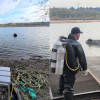New research from the University of Victoria maps the Earth’s most precious natural resource, hidden groundwater.
An international group of hydrologists have produced the first data-driven estimate of the Earth’s total supply of ground water. The study was led by Tom Gleeson of the University of Victoria with co-authors at the University of Texas at Austin, the University of Calgary and the University of Göttingen, was published Nature Geoscience.
The report shows that less than six per cent of groundwater is in the upper two kilometres of the Earth’s landmass and is renewable within a human lifetime.

"This has never been known before," said Gleeson. "We already know that water levels in lots of aquifers are dropping. We're using our groundwater resources too fast--faster than they're being renewed."
With the growing global demand for water--especially in light of climate change--this study provides important information to water managers and policy developers as well as scientists from fields such as hydrology, atmospheric science, geochemistry and oceanography to better manage groundwater resources in a sustainable way, he says.
Using multiple datasets (including data from close to a million watersheds), and more than 40,000 groundwater models, the study estimates a total volume of nearly 23 million cubic kilometres of total groundwater of which 0.35 million cubic kilometres is younger than 50-years-old.
Young and old groundwater are fundamentally different in how they interact with the rest of the water and climate cycles. Old groundwater is found deeper and is often used as a water resource for agriculture and industry. Sometimes it contains arsenic or uranium and is often more salty than ocean water. In some areas, the briny water is so old, isolated and stagnant it should be thought of as non-renewable, says Gleeson.

The volume of modern groundwater dwarfs all other components of the active water cycle and is a more renewable resource but, because it's closer to surface water and is faster-moving than old groundwater, it's also more vulnerable to climate change and contamination by human activities.
The study's maps show most modern groundwater in tropical and mountain regions. Some of the largest deposits are in the Amazon Basin, the Congo, Indonesia, and in North and Central America running along the Rockies and the western cordillera to the tip of South America. High northern latitudes are excluded from the data because satellite data doesn't accurately cover these latitudes. Regardless, this area is largely under permafrost with little groundwater. The least amount of modern groundwater is not surprisingly in more arid regions such as the Sahara.
The next step in painting a full picture of how quickly we're depleting both old and modern groundwater is to analyze volumes of groundwater in relation to how much is being used and depleted.
















